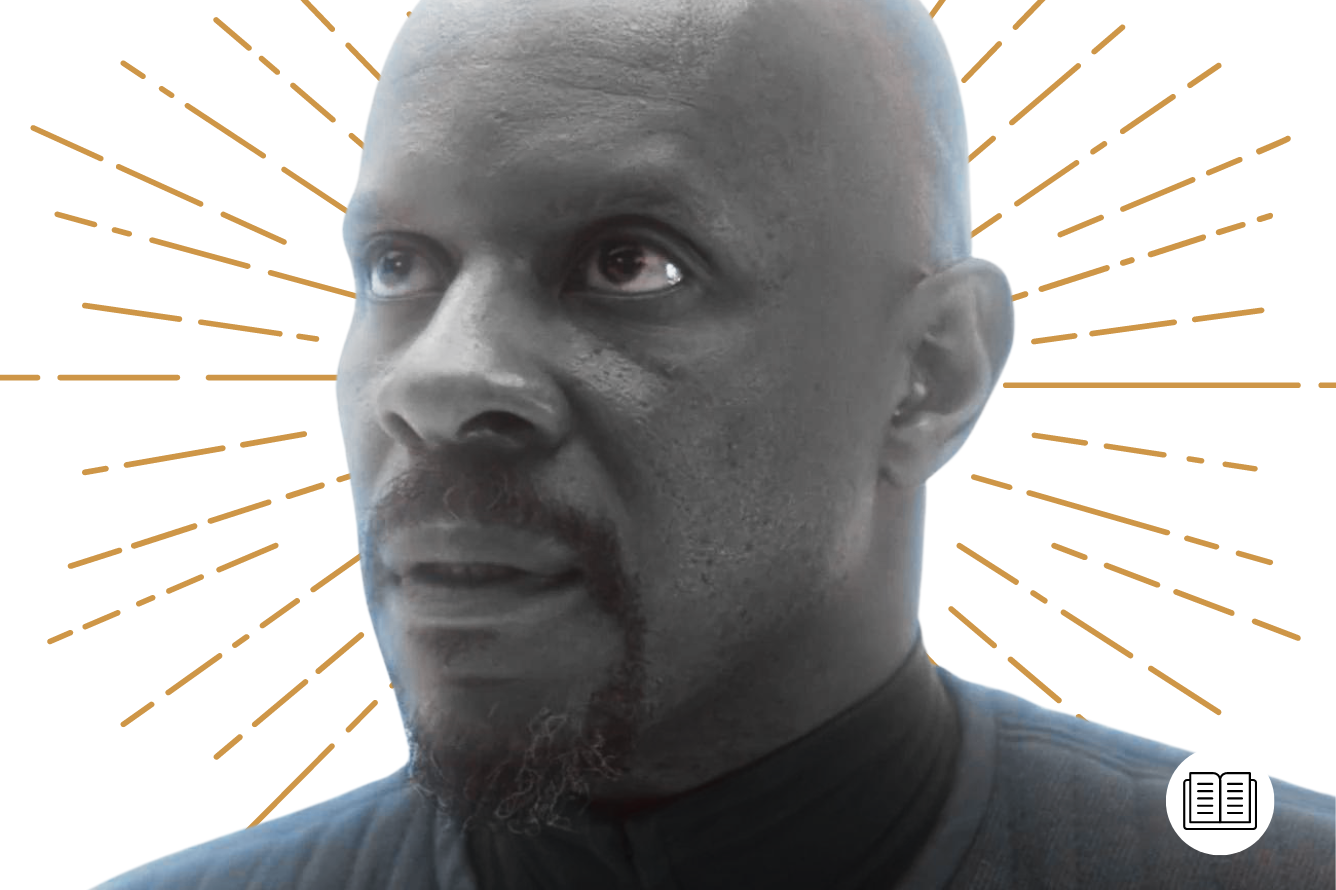In the Star Trek: The Next Generation episode ‘Who Watches the Watchers’ (S3, Ep4), Captain Jean-Luc Picard (Patrick Stewart) temporarily becomes a god. A tribe of proto-Vulcans on an undeveloped planet glimpse a Federation observation post when its holographic disguise malfunctions, and after Picard is witnessed captaining Enterprise by the primitives, a mini-religion centered on his divinity kicks up. How we perceive power, what it means to us; it’s all a matter of perspective, the show says before the crew moves on to the next mission, the next crisis, the next adventure.
Star Trek: Deep Space Nine has a track record for succeeding TNG’s easily-resolved thought experiments with more complex and thorny theses. Over multiple seasons, the show picks up ‘Who Watches the Watchers’ ideas and explores not only the polarising ways we perceive and understand unexplained phenomena but shows, inadvertently or not, the perception gaps between a 24th-century ensemble and a present-day audience. Because, depending on how you look at it, Deep Space Nine’s Captain Benjamin Sisko (Avery Brooks) might be insane.
Mental Health in Star Trek
Star Trek has always shown its limitations when discussing mental illness. In ways, the stigma surrounding Barclay’s social anxiety and addiction, or the slowness with which people adapt to Nog’s post-amputation PTSD illuminates how Trek can only be as utopic or prophetic as the minds of its writers–and mental illness was not a prophesying priority in those 20th-century writers rooms. This is potentially why the issue of Sisko’s madness is so fascinating; while we know it was not explicitly intended for the audience to read his behavior and experiences as such, the disappointing ways Trek’s writers would tackle the topic of mental illness means the most resonant looks at his psychology come from outside the text.

On top of peacekeeping a recently liberated Bajor from a space station formerly run by their Cardassian oppressors, Benjamin Sisko has barely gotten through the door of Deep Space Nine before Bajor’s spiritual leader declares him Emissary to the Prophets. Soon after, he meets said Prophets: incorporeal aliens from inside a nearby wormhole who use his crew and family as mouthpieces to instruct him. While it’s an uncomfortable mantle for Benjamin (the deeply spiritual Bajoran people are divided on a Federation outsider being named their Emissary), he knows it can be used to his advantage to usher Bajor into the Federation. Besides, thanks to the random interjections into his own mind, it’s not a title he bears passively.
Sisko’s Visions in the Deep Space Nine episode ‘Rapture’
Astral projections/hallucinations/communions with gods have been explored playfully before (Hello, Q), but only here do we see them have a recurring effect on someone’s leadership faculties. (They’ve even been interpreted as a form of treatment for the PTSD Sisko suffers after losing his wife.) After a period of relative stability, in the Star Trek: Deep Space Nine episode ‘Rapture’ (S5, Ep10), Sisko becomes fascinated with the lost Bajoran city B’hala, now relegated to myth, after what Dr. Bashir (Alexander Siddig) describes as a “post neural shock” from a holosuite accident. He becomes convinced that he as Emissary is the only hope of discovering B’hala, and after he starts seeing symbols in his son’s cooking, people start to get nervous. Soon his feverish obsession will have him dealing out prophecies and, more worryingly, collapsing to the floor.

This is the first significant coding of Sisko’s visions as pathology DS9 offers its audience; the external materialization of signs pointing to an internal obsession that revolves completely around only the sufferer and deals him incredible psychic harm. While these beats are commonplace in stories of obsessed geniuses on the cusp of great discovery, it’s always in tandem with the idea that their quest is so magnificent, one must push themselves to the edge of sanity to grasp it. And just like his forebears, the symptoms of Sisko’s “post neural shock” and psychological mania are validated by him actually discovering B’hala. As Star Trek writer Ronald D. Moore says about ‘Rapture’: “You’re not going to find many shows where the lead character is having visions from an alien god and believing them.”
This, of course, highlights the other complication with reading Sisko’s symptoms as pathology – the hallucinations he experiences have an in-universe explanation. The Prophets are not deities, but an advanced alien race living in a wormhole, who communicate in a manner unintelligible to carbon-based lifeforms. This narrative device prohibits ‘Rapture’ from being clearly read as a story directly about, or even a metaphor for, mental illness; such an interpretation of Sisko’s visions is just as loaded an interpretation as the Bajorans believing they are divine, even if the extent of his obsession and union with the wormhole aliens causes him psychological damage.

But Deep Space Nine wasn’t written by religious Bajorans, Starfleet officials, or even omnipotent, incorporeal aliens. It is a series written, as Emily St. James reminds us, by a group of human beings fixed by time, place, and identity in 1990s America, and every component of its world was constructed and mutable by people who do not exist in the fictional world the show explores. There is nothing in the show that can’t be interpreted as relating to human experience; in fact, that’s arguably the only way to understand its themes. Wormhole aliens and Bajoran religion don’t exist, and their existence can only be refracted through the lens of human speculative fiction writers. Every character in DS9 is designed to be a surrogate for representing cultural and ethical stances we can identify, including the experience of suffering and witnessing physical and mental illnesses.
What They Wrote and What We See
The perspectives that the writers color within the text–between the practical, logical Starfleet and the, according to Starfleet, stubbornly faithful Bajorans–make ‘Rapture’ a less clear-cut “they’re right and they’re wrong” scenario as in ‘Who Watches the Watchers’. While we get to see both the tension and the harmony that exists between the contrasting viewpoints, there exists the same dynamics between what the audience sees and how the fictional characters interpret what Sisko goes through. What our captain goes through visually and emotionally resembles psychosis, but the politics of three different lifeforms cloud the gulf that exists between spectator and sufferer.
Which perspective do we find ourselves drawn to more? Do we follow that typical Starfleet skepticism around religious matters in Trek, now doubly hesitant to validate religiosity with one of their officers at the center of it? A life-saving operation that will sever Sisko’s link to the Prophets may be his only hope, but you wonder if Starfleet thinks this will kill two birds with one stone.

Or do we relate more to the Bajorans, a people with little hope for salvation, who reject the scientific, wormhole-alien explanation for Sisko’s visions in lieu of one that speaks more to their shared cultural experience? With this, they potentially align more with us as an audience, because when we see someone in the throes of obsession and agony like Sisko, the explanation that wormhole aliens are making him feel this just doesn’t make as much sense as our instinctive reactions. But where the Bajorans see a communion with deities, we recognize a man losing grasp of his sanity.
It’s disingenuous to suggest DS9’s writers intended for us to see the Bajorans’ reverence of Sisko as a tool for meta-interrogation of the limited fictive viewpoints the characters are imbued with by writers. Seeing visions from powerful beings is one of the most common tropes in not only sci-fi but storytelling in general. But ‘Rapture’ marked a turning point in how Sisko related his psychic connections, introducing life-threatening pain to his relationship with the Prophets. But in order to provoke further self-reflection, Sisko must see himself in a mirror.
Dukat’s Breakdown in the Deep Space Nine episode ‘Waltz’
The former commander of Deep Space Nine and high-ranking military official in the Cardassian government, Gul Dukat (Marc Alaimo) spent about half the show lurking venomously just around the corner for the crew on Deep Space Nine. Once the Dominion War breaks out, Dukat spends a spell in Federation captivity after his illegitimate half-Bajoran daughter is killed, and it’s known to Sisko that as a result, his sanity is degrading. “Maybe I prefer to think of him as a crazy man, a broken man,” Sisko says at the start of the Star Trek: Deep Space Nine episode ‘Waltz’ (S6, Ep11), unaware he’ll have to consider the totality of his enemy’s character soon enough, as a crash will strand them on a barren planet awaiting whatever rescue reaches them first.

Dukat’s loyalty to a fascist empire has now proven misplaced, adding an identity crisis to his grief, and – his pride all that remains of him – he tries to extract from Sisko confirmation that the captain regards him with respect. Maybe because now he’s unsupported by his empire, Dukat feels uncertain over the necessity for his barbaric acts during the Bajoran occupation. In ‘Waltz’, his unstable inner conscience gets brought to life for us, in the form of hallucinatory allies and enemies from the Dominion and Deep Space Nine, so he can talk to people who aren’t really there. Sound familiar?
The decision to showcase someone’s interiority like this is understandably common in television (it’s cheap!), but for the person who witnesses Dukat interacting with hallucinatory people, it’s revealing. Just like Dukat, Sisko has spent years seeing his friends and colleagues used as mouthpieces to probe his psychology, invisible to everyone else. But here, the fictional world offers no in-universe explanation to divert us from considering the character’s experience as that of mental illness – that’s exactly how we’re to read Dukat’s behavior.

Fans have critiqued the broad-strokes transformation into a raving, cackling villain from this episode onwards, but it directly correlates with everything in his character we’ve seen before: a perfect blend of humiliation, fury, and grief has broken down his sneering, calculating persona into a raw, broken, genocidal fury. The manner by which he accesses this may be a far cry from the benevolent apparitions Sisko experiences, but it’s via an identical dramatic tool. When Kira (Nana Visitor), Gul Damar (Casey Biggs), and Weyoun (Jeffrey Comb) appear to him as distorted reflections of his conscience, ego, and honor, it doesn’t give him more clarity, it sends him further down a rabbit hole of insanity. Where Sisko found himself as part of an expansive cosmic body, Dukat is subjected to his own bleeding mind, all the untempered flares of a narcissistic brain. This is not esoteric, this is psychological; what Sisko’s condition in ‘Rapture’ was instinctively felt like is here written explicitly.
Sisko and Dukat: Pulling Back from the Mirror
Avery Brooks described Deep Space Nine as a journey inwards rather than beyond, and such an idea is never more perverted than here as Sisko watches a man dissolve into a corrupted state. But there exists a gulf between ‘Waltz’ and ‘Rapture’, where two morally polarised characters have suffered extreme mental distress and lost track of reality; but only Dukat is otherized and meant to be viewed as insane. The similarity between them is maybe why Sisko prefers to think of Dukat as “a crazy man, a broken man”, such descriptors have a distancing effect from the uncomfortable grey zone that is his own psychology.
Perhaps this illustrates a limitation of Deep Space Nine’s writing powers; the showrunner and writers couldn’t imagine a way to explore two narratively distinct psychological states without repeating the same dramatic tool, save for dressing them each up with different stylistic and performance nuances. It’s possible the only way they could comfortably pen a mentally unstable character was in the trope of the dangerous madman. But intentional or not, there exists in the show a parallel experience; mental projections leading to physiological anguish, but only one is allowed spirituality, the other relegated to delusion. It’s impossible to fully sever the connective tissue between them.
Once Sisko is rescued, he doesn’t allow himself any reflection on unsettling comparisons between his enemy and himself, declaring he must kill Dukat, and that “There is such a thing as truly evil.” Looking into a warped mirror may have proved too disturbing for Sisko, and he has to kill what he sees before it undoes him too. The writers intended ‘Waltz’ as a reaction against fans over-sympathizing with the charismatic Dukat, but what Sisko witnesses have connotations that stretch until the finale. If Dukat is lost, Sisko walks the same path; two souls bonded by insanity, plummeting ever-downward into gaping, fiery earth.
Benny in Crisis in the Deep Space Nine episode ‘Far Beyond the Stars’
It took two weeks for the mirror in ‘Waltz’ to be turned directly onto Sisko, as a couple of episodes later saw ‘Far Beyond the Stars’ (S6, Ep13). Sisko falls into a flashback/fantasy/timesplice where he is Benny Russell, a jobbing scienc-fiction writer in ’50s New York, surrounded by a host of colorful publishing characters (all played by DS9 regulars). Suddenly, the stories of Deep Space Nine and their Black captain come fully formed to him, but the racially aggravated pushback he receives from his editor and broader bigoted society pushes him to a colossal mental breakdown, an antithesis to every mannered speech Picard gave and one of Avery Brooks’ finest hours. “I am a human being, dammit. You can deny me all you want, but you cannot deny Ben Sisko; he exists,” Benny howls. Denying Deep Space Nine is suppression of Benny’s voice and agency, and it renders him worthless – a far cry from being the “Chosen One” Emissary.

Here, we get to see Sisko’s visions devoid of the futuristic context that obstructs us from understanding them as insanity. Like Sisko, Benny receives visions of something that feels impossibly foreign, he knows for a fact they are true, but there is no diligent Bajor or patient Starfleet to help him unpack the wonders of the unknown. An ignorant and fearful society only regards his work as fantasy and his dedication as delirium. What’s more, anything that gives Benny power, that challenges the political and social regime, is a threat; ’50s America has not yet adopted the “go where no man has gone before” mantra Starfleet operates by. ‘Far Beyond the Stars’ is an acknowledgment of the real-life context surrounding Sisko’s benevolent visions; how your condition is viewed is all cultural, no affliction is objective and consistent, and your treatment depends on how your pathology is seen.
Of course, ‘Far Beyond the Stars’ is not a perfectly clear look at Sisko’s condition without sci-fi drippings; it has a distinct cultural context of its own. The violent racism of Benny’s contemporary society imposes punitive, inhumane obstructions to his liberty and health–a regressive world that ended up provoking Gene Roddenberry’s original vision of Star Trek, a world devoid of all the things that punish Benny Russell.
The fact that we get to see Sisko, as Benny, have a brutal mental breakdown confirms everything that was only inferred from how we’ve seen the Prophets invading and affecting Sisko’s mind. A changing of time, place, and power gives a direct line of sight into how Sisko could suffer without the complicated dynamics of Bajor and Starfleet crowding him–amongst all the diplomacy there exists someone whose mind is being drastically changed outside his control.

Giving Benny a voice, one he’s been consistently refused as a Black man working as an invisible writer, is not something that can be rescinded, meaning that when everyone around him denies something he knows to be paramount and unyielding, he’s can’t submit, even if his outburst costs him his own psyche. (The Prophets show Benny in psychiatric care in ‘Shadows and Symbols’ – S7, Ep2.) What if Sisko didn’t have the authority of a loyal crew and Starfleet military behind him when he admitted to his commune with the Prophets? What if the Bajorans and Cardassians thought his visions were sacrilege or treasonous?
Validation is the key separator in Sisko and Benny’s experience. Sisko cannot other Benny like he did Dukat; to do so would undermine the pain Sisko knows is real, and the fact they share the same face and voice mean he’s inescapably bonded with Benny’s mind and actions. But even though Sisko knows Benny was right, that Deep Space Nine exists, nothing can be done about the alienation Benny suffers from voicing this truth. Mass denial is the catalyst needed to ruin Benny; it is the distinction between Sisko’s visions, and Benny’s madness. Benny didn’t break down on the floor because his view of Deep Space Nine was too overwhelming, but because he finally grasped a concrete, impenetrable truth, and he was systematically denied voicing it.
To Ignore Sisko’s Struggle is to Ignore Him Entirely
Deep Space Nine signals in several parts its intention to exist in the Star Trek canon as a rumination on those we couldn’t save, on living with the pain and sorrow of crises not resolved. It’s in Sisko’s acceptance of his war crime, it’s in the title of the finale, ‘What You Leave Behind’ (S7, Ep25). And it’s there in the character of Benny Russell, a man who knew of a brighter future, but whose society punished him for his transgressions. While Sisko is lauded as a prophet, Benny is institutionalized; trapped, lost, and unreachable. There is no joy in the connections he makes to Sisko and Deep Space Nine neither can find a way to validate them. And there is no way Sisko can go on ignoring the ways his mind has been altered.
I’ll admit my own experiences with mental illness make me more likely to read its presence in whatever I watch. But such an instinct is common for Trek fans, and it’s even more appropriate for a show such as DS9, which always wanted to make clear that with new life and new civilizations, there must be new ways to think and feel. By the time Sisko is absorbed by the Prophets, he’s been confronted not only with the dangerous corners of the galaxy but with the limits of his own mind. These three episodes primarily have different thematic messages; Bajoran faith, Dukat’s moral collapse, racism in America – psychosis and insanity always feel like a smaller focus, if even the author’s concern at all.
Even if these episodes have different thematic concerns, Star Trek has always encouraged thinking beyond, and the same message applies to how we read the text; we must engage with Trek’s expansive meanings beyond what the writers prescribed. There is a keen human pain on display throughout the show, one that the sufferer and onlookers don’t even classify as the way it appears to audiences.
Did he end up walking the path of the Prophets? Did he truly defeat Dukat? Is all of DS9 in Benny Russell’s imagination? None of these questions feel pertinent if, to reach an answer, the pain Sisko kept on feeling throughout goes unacknowledged.
This article was first published on October 4th, 2022, on the original Companion website.
The cost of your membership has allowed us to mentor new writers and allowed us to reflect the diversity of voices within fandom. None of this is possible without you. Thank you. 🙂










